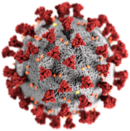Wikipedia:Main Page history/2020 March 27
From today's featured article Illustration of a SARS-CoV-2 virion A virus is an infectious agent that reproduces inside the cells of living hosts. Unlike most living things, viruses do not have cells that divide; instead they force infected host cells to produce thousands of identical copies of the original virus, at an extraordinary rate. A virus consists of two or three parts: genes, made from either DNA or RNA, long molecules that carry the genetic information; a protein coat that protects the genes; and in some, an envelope of fat that surrounds and protects them when they are not contained within a host cell (and makes them vulnerable to soap). Viruses spread in different ways; some through the air by people when they cough or sneeze, others by the faecal–oral route, and some by direct contact or during sex. Over 4,800 species have been discovered, many of which cause disease in plants and animals, including common human diseases such as the common cold, chickenpox and cold sores, and serious epidemics and pandemics such as HIV/AIDS, Ebola, influenza, SARS and COVID-19. (Full article...)
Recently featured:
Did you know ...
|
In the newsIgor Matovič
On this day
Sigismund Báthory (d. 1613) · Virginia Minor (b. 1824) · Michael Joseph Savage (d. 1940) |
From today's featured list
Ontario's 444 municipalities cover only 17 per cent of its land mass, yet are home to 99 per cent of its population. The province is the most populous in Canada, with 13,448,494 residents as of the 2016 census, and is third-largest in land area. According to Ontario's Municipal Act, 2001, a municipality is "a geographic area whose inhabitants are incorporated". They provide local or regional municipal government services within either a single-tier or shared two-tier municipal structure. The three municipality types include upper and lower-tier municipalities within the two-tier structure, and single-tier municipalities (unitary authorities) that are exempt from the two-tier structure. Ontario's largest municipality by population is the City of Toronto (skyline pictured), with 2,731,571 residents, while the largest by land area is the City of Greater Sudbury, at 3,228.35 km2 (1,246.47 sq mi). (Full list...)
Today's featured picture

|
Manhood is the third in a series of allegorical oil-on-canvas paintings by American artist Thomas Cole, entitled The Voyage of Life, which represent man's journey through life. In the painting, a now mature man has moved on from the innocence of infancy (Childhood) and the flush of juvenile overconfidence (Youth), to the trials and tribulations of middle age. He glides in his boat among dark, towering crags and gnarled trees, towards turbulent water with projecting rocks. The day is stormy and an angel watches through a rent in the clouds as he prays, his vessel moving ever closer to destruction. This painting, along with the other three in the series, was painted in 1842 and is held by the National Gallery of Art in Washington, D.C. Painting credit: Thomas Cole
Recently featured:
|
Other areas of Wikipedia
- Community portal – Bulletin board, projects, resources and activities covering a wide range of Wikipedia areas.
- Help desk – Ask questions about using Wikipedia.
- Local embassy – For Wikipedia-related communication in languages other than English.
- Reference desk – Serving as virtual librarians, Wikipedia volunteers tackle your questions on a wide range of subjects.
- Site news – Announcements, updates, articles and press releases on Wikipedia and the Wikimedia Foundation.
- Village pump – For discussions about Wikipedia itself, including areas for technical issues and policies.
Wikipedia's sister projects
Wikipedia is hosted by the Wikimedia Foundation, a non-profit organization that also hosts a range of other projects:
Free media repository
Wiki software development
Wikimedia project coordination
Free textbooks and manuals
Free knowledge base
Free-content news
Collection of quotations
Free-content library
Directory of species
Free learning materials and activities
Free travel guide
Dictionary and thesaurus



